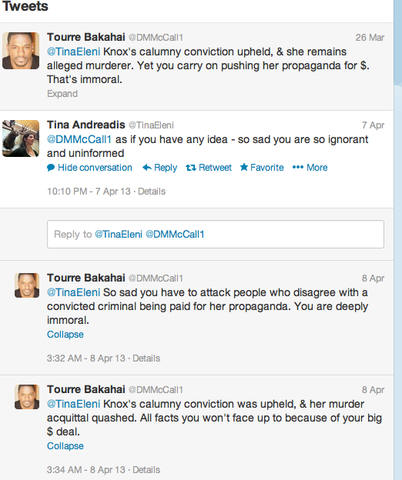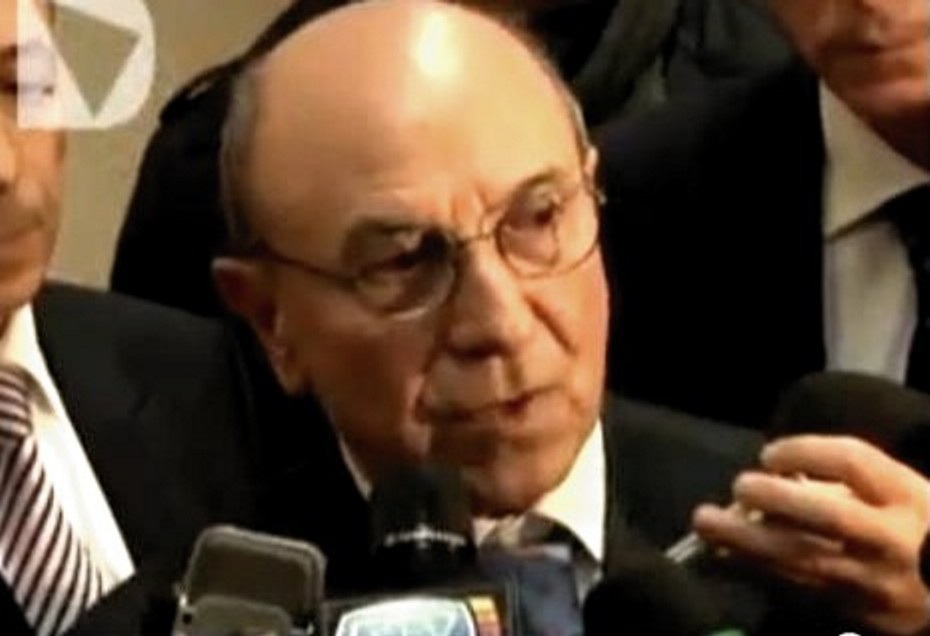
Category: 16 Interrogation hoax
Friday, May 03, 2013
The Amanda Knox Book: Good Reporters Start To Surface Amanda Knox’s False Claims In Droves
Posted by Our Main Posters

[American Ambassador to Italy David Thorne whose reports contradict Knox’s prison claims]
Did ANYBODY think to check Knox’s book for criminal defamations and false claims? Take this glaring “mistake” from page 248.
During the rebuttals, on December 3, each lawyer was given a half hour to counter the closing arguments made over the past two weeks. Speaking for me, Maria criticized Mignini for portraying Meredith as a saint and me as a devil
Really? Prosecutor Mignini said that? So why did the entire media corps report that it was said by Patrick Lumumba’s lawyer Carlo Pacelli? As the BBC reported:
[Mr Pacelli] added: “Who is the real Amanda Knox? Is it the one we see before us here, simple water and soap, the angelic St Maria Goretti?”
“Or is she really a she-devil, a diabolical person focused on sex, drugs and alcohol, living life to the extreme and borderline - is this the Amanda Knox of 1 November 2007?”
So even Mr Pacelli didnt compare Knox to Meredith, or simply call Knox a she-devil to her face. He asked rhetorically if she was a she-devil or a saint. Not exactly unheard of in American courts.
And remember he was addressing someone who would have been quite happy to see Patrick put away for life, cost him two weeks in a cell, entangled her own mother in a cover-up, destroyed Patrick’s business and reputation world-wide, still hasnt paid him money owed, and for lying about him served three years.
Prosecutor Mignini in fact never called Knox anything at all. We can find no record that he did. Again and again he has denied it. And he had no personal need to prosecute Knox, and certainly no need to frame her, despite many pages Knox devotes to trying to prove the reckless claim that he did.
Another false claim: Knox’s claim that Prosecutor Mignini invented the notion of a satanic cult to explain the Monster of Florence murders, also made by Sollecito, is totally untrue.
Dozens of others had suspected and talked about a satanic cult for YEARS before he investigated one loose end in the case. And both that theory and that investigation are back on track - at the recent order of the Supreme Court.
Another false claim: Knox devotes pages to trying to make herself look good on the witness stand at the trial. But Italians who could follow in Italian in real-time ended up suspecting and despising her performance up there. Read what they saw here and here.
Inspired by such conspicuous false claims as these, various reporters have begun to dig. We posted on Knox’s false claims about her prison time and the many disproofs. Italy-based reporter Andrea Vogt uncovers some more.
Knox’s memoir is a vivid personal account of the difficulties of prison life in Italy, complete with claims about inappropriate behaviour by staff. But Knox herself once painted a different picture.
Other documents - including writings Knox penned in her own hand while incarcerated, case files and state department records - conjure up quite another impression of a very different Knox, one who was more sanguine about her experience.
On the attitudes of the prison staff
“The prison staff are really nice,” wrote Knox in her personal prison diary, which was eventually published in Italy under the title Amanda and the Others.
“They check in to make sure I’m okay very often and are very gentle with me. I don’t like the police as much, though they were nice to me in the end, but only because I had named someone for them, when I was very scared and confused.”
She described Italian prisons as “pretty swell”, with a library, a television in her room, a bathroom and a reading lamp. No-one had beaten her up, she wrote, and one guard gave her a pep talk when she was crying in her cell.
Unlike the heavily-edited memoir, these are phrases she handwrote herself, complete with strike-outs, flowery doodles, peace signs and Beatles lyrics.
On the positive HIV result she was given
Both accounts also refer to the devastating but erroneous news from the prison doctor that she had tested positive for HIV, although her diary presents a more relaxed person at this point. “First of all, the guy told me not to worry, it could be a mistake, they’re going to take a second test next week.”
We also know that it was Knox’s own lawyers who leaked the HIV report and list of sex partners. Not the doctor or anyone else. No malice was intended, that is clear, despite her claims.
On her framing of her kindly employer Lumumba
[Knox] writes that she had a flashback to the interrogation, when she felt coerced into a false accusation. “I was weak and terrified that the police would carry out their threats to put me in prison for 30 years, so I broke down and spoke the words they convinced me to say. I said: ‘Patrick - it was Patrick.’”
In her memoir, she describes in detail the morning that she put that accusation in writing, and says the prison guard told her to write it down fast.
Yet in a letter to her lawyers she gives no hint of being rushed or pressured. “I tried writing what I could remember for the police, because I’ve always been better at thinking when I was writing. They gave me time to do this. In this message I wrote about my doubts, my questions and what I knew to be true.”
On her medical examination after arrest
“After my arrest, I was taken downstairs to a room where, in front of a male doctor, female nurse, and a few female police officers, I was told to strip naked and spread my legs. I was embarrassed because of my nudity, my period - I felt frustrated and helpless.”
The doctor inspected, measured and photographed her private parts, she writes - “the most dehumanising, degrading experience I had ever been through”.
But in the 9 November letter to her lawyers, she described a far more routine experience.
“During this time I was checked out by medics. I had my picture taken as well as more copies of my fingerprints. They took my shoes and my phone. I wanted to go home but they told me to wait. And that eventually I was to be arrested. Then I was taken here, to the prison, in the last car of three that carried Patrick, then Raffaele, then me to prison.”
On her persona and mood swings in prison
She says she was often suicidal, but recollections of prison staff and other inmates differ. Flores Innocenzia de Jesus, a woman incarcerated with Amanda in 2010 described Knox as sunny and popular among the children who were in Capanne with their mothers, and recalled her avid participation in music and theatrical events. She also held a sought-after job taking orders and delivering goods to inmates from the prison dispensary.
“Most of the time when we spoke during our exercise break, the kids would call her and she would go and play with them,” de Jesus told me.
And on what US officlals and her own lawyers perceived
State department cables, released through the Freedom of Information Act, show that between 2007 and 2009, three different high-level diplomats from Rome (Ambassador Ronald Spogli, Deputy Chief Elizabeth Dibble and Ambassador David Thorne) were among those reviewing Knox’s case.
Embassy officials visited regularly. Records show one consular official visited Knox on 12 November, soon after her arrest. A few weeks later she wrote in her diary how the visits of embassy officials improved her experience….
In 2008 and 2009, she was visited by two embassy officials at a time, six times. Ambassador David Thorne, whose name appears at the bottom of cables in August, November and December of 2009, is the brother- in-law of US Secretary of State John Kerry (at that time chairman of the Senate Foreign Relations Committee).
If the diplomats knew anything of the “harrowing prison hell” Knox was going through (as one paper put it), they are keeping those reports under wraps. Neither Kerry nor any other prominent US politician has made any public complaints. Even today, her Italian lawyers maintain she was not mistreated.
Half a dozen obvious false claims and defamations here. We estimate we will uncover well over one hundred more.
Thursday, April 11, 2013
Knox Book Put On Hold In UK As Legal Implications Of Blood Money For Still-Accused Finally Sink In
Posted by Our Main Posters
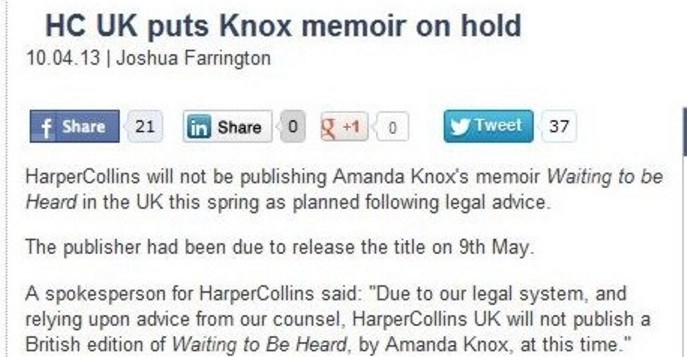
There have always been several huge problems in the promotion of Amanda Knox.
One problem is that Knox is not the real victim in the case and a great deal of compassion still resides for Meredith. Earning windfall blood money from the cruel death of a claimed close friend is hardly a classy way to go.
A second problem is that we are still only at the end of the second act of a three act play in terms of the trials and appeals, and the Italian Supreme Court in the third act to come will almost certainly be no gullible pushover. And a whining or inaccurate book or movie demonising Italy and Italians (as her complaints about Capanne already have done) might not help her legal prospects one little bit.
A third problem is that Italy’s officialdom and its population tend to maintain a hard and unblinking belief in the evidence against Sollecito and Knox, especially as the million dollar PR campaign largely flew below the radar there and they saw much of the hard case and a callous Knox live on TV. For example in Florence and Milan....
*******
Guess when we first posted those paragraphs above? Actually we posted them fifteen months ago on 6 January 2012.
And finally today fifteen months later HarperCollins UK suspended their publication of Knox’s book. Can the HarperCollins US suspension of the book be far behind?
We are not particularly given to directing legal advice to Amanda Knox - we think she should rethink and answer all the open questions - but the leeching of Knox-Mellas blood money going back nearly five years is absolute anathema to Meredith’s family.
So we have posted five subsequent times, pointing out to the Knox-Melasses and Robert Barnett and Ted Simon what should have been very, very obvious to them when they did their due diligence in Italy on the book:
Publishing to impugn Italian justice officials while still accused in an ongoing legal process is a contempt of court felony in Italy.
Ask Raffael Sollecito. He is now under investigation by the Florence chief prosecutor and could face millions in damages and further years in prison. So could his publishers Simon & Schuster and his shadow-writer Andrew Gumbel.
Not to mention that Sollecito is probably wrecking any chances he had at the repeat of the appeal. Does Amanda Knox REALLY want to be in the same boat? And do her shadow-writer and her publishers too?
Here are our other previous posts on her book:
- Were Prospective Knox Publishers Given The Full Score On The Likely Legal Future Of This Case?
- HarperCollins: A Commendably Balanced Report By The UK Daily Telegraph’s Iain Hollingshead
- HarperCollins: Perhaps This Explains Why Jonathan Burnham Was Inspired To Take Such A Seeming Risk
- My Letter To Claire Wachtell of HarperCollins Protesting How Distasteful Knox’s Book Promises To Be
Below: The HarperCollins US publicist Tina Andreadis (aka Tina Eleni) participated in the very very very odd Twitter exchange at bottom. She seems unfamiliar with the concept of “contempt of court” and the criminal and civil nightmares headed Simon & Schuster’s and Sollcito’s way.
Perhaps Tina Andreadis was out of the loop when her publishing company did its due diligence.
Thanks to our main poster Bedelia for this astonishing catch.
Tuesday, March 26, 2013
More Pervasive Myths We Will Nail In Our Various Hoaxes Series In Due Course
Posted by Our Main Posters

We hope you made it through those amazing Powerpoints on the case for guilt introduced in the post directly below.
We have created around two dozen other Powerpoints also. Here are all Kermit’s Powerpoints and here are all other Powerpoints.
Below are summaries of some more key and very pervasive myths which you can easily spot in today’s media in the US and UK (though never in Italy) which we will nail in depth soon in other longer posts.
The real hard truths can all already be found here on TJMK if you search for them. Please feel free to email us if you need some quick guidance.
1) That Knox and Sollecito maybe face a “retrial”
Rubbish. At most they face a re-run, done properly, of a poorly managed, legally and scientifically incompetent, and highly biased first appeal. It SHOULD look like any US or UK appeal: limited, fast, focusing only on a few points, no consultants, no witnesses, no attempt to run a new first-level trial.
2) That any such “retrial” is a case of double jeopardy
Rubbish. Under Italian law Knox and Sollecito still stand accused of murder and other crimes until the final appeal court (in this case the Supreme Court) signs off, so they were NEVER found “innocent, end of story” at first appeal level. There’s no question of double jeopardy; and the exact-same rules apply in the US.
3) That Amanda Knox was forced into “confessing”
Rubbish. This is the misleading label for her framing of Patrick Lumumba. She spilled the beans fast and vociferously (and repeatedly) after Sollecito who was being interrogated in another room sold her out and said she had made him tell lies. Interrogations were short, she had an interpreter, she was not interrogated as a suspect without a lawyer, and she had refreshments.
4) That all the DNA evidence was thrown out by Hellmann
Rubbish. Hellmann (who is now edged out in disgrace) and Zanetti were not criminal judges, and this was their first DNA case. They were totally at sea. By innuendo, two consultants, illegally appointed and ill qualified, tried to make out there was possible contamination. They proved nothing. They ADMITTED Meredith’s DNA was on the big knife and that Sollecito’s DNA was on the bra clasp. There was lots of other incriminating DNA evidence outside Meredith’s door.
5) That “the” prosecutor was rogue, satanist, and out of control.
Rubbish. The lead prosecutor at trial (Mignini) is straight as an arrow and very admired, and has no interest in satanism. His work was checked by a co-prosecutor, other prosecutors, and many judges. He is in line for a major promotion, and has no dark cloud hanging over his head. The Supreme Court TWICE came down strongly in his favor in the part several weeks, and he is about to be promoted to Deputy Chief Prosecutor for the Province of Umbria.
Final warning:
Disregard everything coming from ABC, CNN, and any Seattle TV station. They are highly biased for commercial reasons, they don’t know the case, and they have essentially been serial-lying to the American public.
Monday, February 18, 2013
Raffaele Sollecito Now Under Formal Investigation For New Crimes Apparently Unprecedented
Posted by Our Main Posters
Breaking news. The Chief Prosecutor for Tuscany Dr Quattrocchi (above and below) has taken this investigation of Sollecito behind the scenes. Dr Quattrocchi is actually under no compulsion to make any of the Perugia and Rome complaints public before his investigation is complete. He has ordered all documents removed from the public domain. This is specifically to give the defense and their PR no advantage, and to make sure those others in Perugia who are going to complain about being defamed do so without harm.
Overview
This is a contempt of court case as court officials have been impugned. This is Wikipedia’s definition of “contempt of court” under US and UK common law.
Contempt of court is a court order which in the context of a court trial or hearing, declares a person or organization to have disobeyed or been disrespectful of the court’s authority.
Often referred to simply as “contempt,” such as a person “held in contempt,” it is the judge’s strongest power to impose sanctions for acts which disrupt the court’s normal process.
A finding of contempt of court may result from a failure to obey a lawful order of a court, showing disrespect for the judge, disruption of the proceedings through poor behaviour, or publication of material deemed likely to jeopardize a fair trial.
A judge may impose sanctions such as a fine or jail for someone found guilty of contempt of court.
We may now find out much more about the equivalent under Italian law.
When Raffaele Sollecito and Amanda Knox were released at the end of 2011, the prosecution filed a Supreme Court appeal within the allotted period. This automatically meant that Sollecito and Knox still stood accused of crimes until the Supreme Court finally signs off.
Typically Italian defendants in such a legal status get good legal advice, on the lines of “Shut up and keep your heads down. We need to be the only ones doing the talking here.”
Here such advice may or may not have been forthcoming, but the public record strongly suggests it was not. In fact Sollecios entire legal team is credited by both himelf and his shadow writer Andrew Gumbel with helping. This is what Gumbel wrote in his Acknowledgments:
Donatella Donati in Luca Maori’s office gave up many hours to make the official documentation available and to present it all in a cogent order. She’s a largely unsung hero in this story and deserves recognition for her extraordinary efforts on Raffaele’s behalf. Giulia Bongiorno, Luca Maori, and Tiziano Tedeschi answered questions and made comments on parts of the manuscript.
In the same Acknowledgments Sollecito credits the following.
I was lucky to have a crack legal team who showed their devotion to the truth and, in some cases, did not even request payment. The team of lawyers and consultants included Adriano Tagliabracci, Francesco Vinci, Bruno Pellero, Francesco Introna, Giulia Bongiorno, Maurizio Parisi, Daniela Rocchi, Luca Maori, Donatella Donati, Marco Brusco, Aldo Poggioni, Delfo Berretti, Tiziano Tedeschi, and Antonio D’Ambrosio.
Interestingly, Luca Maori has already left Sollecio’s legal team, and all eyes are now on Giulia Bongiorno. Buy plenty of popcorn. Lawsuits could fly between lawyers and family.
Since the end of 2011 Curt Knox’s forces seem to have have gone full steam ahead with their own vilifications of the Italian prosecutors, police, judges, and witnesses - in fact almost anyone who had any role in 2009 in finding them guilty, or came to believe that was a fair finding. Ourselves included.
In late 2012 Curt Knox apparently invited all the most fervent of these attackers to Seattle, including Frank Sforza and Bruce Fischer, as some sort of reward for their legally very ill-advised campaign. Buy plenty more popcorn. Lawsuits could fly here as well.
Raffele Sollecito’s forces in Italy had been a lot more restrained.
But at a stroke, the shrillness of Raffaele Sollecito leapfrogged that of Amanda Knox’s forces, with the publication of his book Honor Bound by Simon and Schuster in English in the UK and US last September,
INSTANTLY the book became notorious in Italy, because excerpts were read out by an Italian reporter in New York on the national television show Porta a Porta. Raffele Sollecito’s father Francesco was on that show, and he was increasingly forced to admit a key claim in the book was invented. It simply never happened. His son made it up.
The false claim by his son that Francesco was made to repudiate - it reappears over many pages - concerned a claimed deal engineered by his family and offered by the prosecution to Sollecito.
The deal he claimed was to roll over on Amanda Knox, and if Sollecito did so, he would be home free.
Following the Porta a Porta show, the book (obtainable on UK Amazon, where many false claims are repeated in the reviews) began to make its rounds in Italy. It took some time before many official parties accused of crimes by Sollecito obtained copies and started to explore their own legal possibilities. They are apparently still far from finished.
At the end of last week, the Chief Prosecutor for Tuscany Giuseppe Quattrocchi received the first official request from Perugia, which is to investigate 12 very serious claims in the book against the prosecution and the legal institutions of Italy. The complaint nominates a number of witnesses.
The Prosecution office of Florence now has a maximum of six months to investigate whether there is a case against Sollecito and other named parties. If so, they will steer it through the hoops of the Italian process.
The potential ripple effects of this appear to us to stretch on and on. They could come to engulf both legal teams (credited in the book with helping) and all of the PR for both defendants. Sollecito’s publisher and shadow writer are specifically named in the complaint
If Amanda Knox is not let off the hook by the Italian Supreme Court late in March (the outcome we consider most likely, given the great strength of the appeal) the smart way for Knox to go in light of this could be to junk all her websites, her book, and her interviews, and throw her supporters under the bus. Plus maybe get smarter lawyers - the aggressive and inexperienced Dalla Vedova does her no favors.
Keeping Amanda Knox’s head out of this deadly new line of fire may be very late - but maybe better late than never.
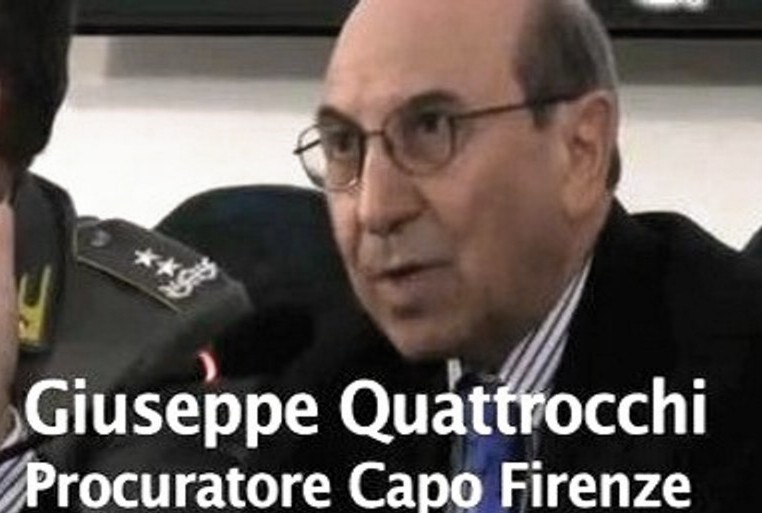
Wednesday, December 12, 2012
Simon & Schuster Seem To Be Seriously Rattled Over Lack Of Due Diligence On Sollecito’s Book
Posted by Peter Quennell

See this emailed exchange which took place late today.
What Simon & Schuster’s agent is complaining about was a chronological reordering (behind the scenes and not linked to from the front page) of these many corrections here. Our Kindle and hardcover copies were legally purchased. Simon & Schuster put about 1/4 of the book on the front of their own website, and Google Books also carries about 1/4 of the book to read free.
Admittedly, our corrections may have been quite a shock. However, we didnt cause the book sales to tank. All of our past posts on Raffaele Sollecito’s book can be seen here.
*******
Mr Eraj Siddiqui
119 South B Street Suite A,
San Mateo, CA 94401
Dear Mr Siddiqui
Thank you for your “Verified DMCA Removal Request from Attributor” copied below.
The book you refer to appears to contain up to 30 instances of criminal defamation under Italian law and literally hundreds of wrong and injurious statements that are hurtful to many fine officials in Italy.
We have full legal rights to point out the myriad mistakes in the book. In fact a defamation of a prosecutor in the book has ALREADY been admitted on Italian national TV by the writer’s own father in Rome.
That Simon & Schuster apparently failed to do their legal and factual due diligence on the book prior to publishing seems to us to be absolutely nobody’s fault but their own. They are hardly new at this game.
Nice try, but sorry, no cigar.
Peter Quennell
*******
Dear Sir/Madam,
I certify under penalty of perjury, that I am an agent authorized to act on behalf of the Rights Holder identified below, the owner of certain intellectual property rights in the Work(s) identified below.
I have a good faith belief that the information contained in this notice is accurate, and that the page or material listed below is not authorized by the Rights Owner, its agents, or the law for use by the individual(s) associated with the identified page listed below or their agents.
To the extent that the Digital Millennium Copyright Act, the European Union’s Directive on the Harmonisation of Certain Aspects of Copyright and Related Rights in the Information Society (2001/29/EC), and/or other laws and regulations relevant in European Union member states or other jurisdictions apply to your service, if at all, I HEREBY DEMAND THAT YOU ACT EXPEDITIOUSLY TO REMOVE OR DISABLE ACCESS TO THE PAGE(S) OR MATERIAL(S) at the Infringing URL(s) identified below.
Note that in some cases the pages/material may have been removed after the sending of this notice but prior to your review.
My contact information is as follows:
Organization name: Attributor Corporation as agent for Simon & Schuster Inc.
Email: .(JavaScript must be enabled to view this email address)
Phone: 650.306.9474
Mailing address:
119 South B Street
Suite A,
San Mateo, CA 94401
Nothing contained in this letter or in any attachments constitutes a waiver or relinquishment of any right or remedy possessed by the Rights Holder, or any affiliated party, all of which are expressly reserved.
My electronic signature follows:
Sincerely,
/Eraj Siddiqui/
Eraj Siddiqui
Attributor, Inc.
*** INFRINGING PAGE OR MATERIAL ***
Infringing page/material that I demand be disabled or removed in consideration of the above:
Rights Holder: Simon & Schuster
Original Work: Honor Bound
Infringing URL: https://truejustice.org/ee/index.php?/tjmksollecitosbook/P0/
Infringing URL: https://truejustice.org/ee/index.php?/tjmksollecitosbook/P5/
Infringing URL: https://truejustice.org/ee/index.php?/tjmksollecitosbook/P10/
Saturday, October 20, 2012
Exploding Nightmare For Lawyers Of The Defense: Torrent of “Mistakes” In Sollecito’s Hapless Book
Posted by Sara
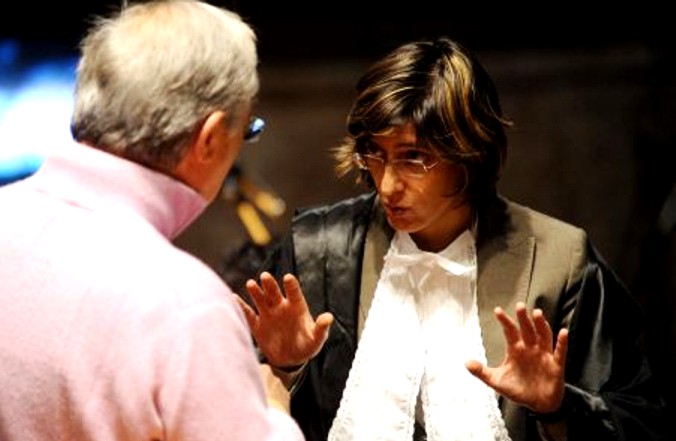
More and more and more wrong facts and libels are being turned up in Sollecito’s pathetic book, both by us here and by an irritated officialdom in Rome and Perugia.
Amanda Knox is rumored to perhaps be mentally unstable and figuratively locked in the attic in Seattle. Now Sollecito seems to have been disappeared back in Italy for his own good as well.
Sollecito’s own lawyers (who have in the past threatened to walk) and his own family have already thrown him to the wolves on Italian TV over just one highly libelous claim and there are an estimated two dozen more still to surface.
Not really a good idea to write a shrill “I’m the real victim here” book unchaperoned, when you have the smug mentality of a 12-year-old. The facts strongly against you. A very bright prosecutor. And a ghost writer whose slobbering over a laughably fictional Sollecito suggests he has a something of a boy-crush.
Raffaele Sollecito has made many stupid claims in his book, but perhaps none is so obvious and more idiotic than his claims about the “lost” emails.
What is it with this guy and the emails? He seems to think (or perhaps, thinks that the readers are stupid enough to believe) that if a computer or a hard drive is destroyed, all the emails in it are lost as well. Come on already, surely they taught him the mechanisms of email in his computer classes.
Look at his statements regarding emails. In chapter 2 (Love and Death) of his book, he describes the morning after the murder -
I’d been up several times in the night””listening to music, answering e-mail, making love””and wanted only to go back to sleep
Right, so he got up many times in the night to answer e-mails. You’d think that this would be his biggest alibi for the night of the murder, right? No, wrong. Raffaele could not prove his alibi because, in his own words -
I did not yet know that the Polizia Postale””supposedly experts in handling technology issues””had seized two of my computers along with Amanda’s and Meredith’s and somehow wrecked three of the four hard disks while trying to decipher them. The bottom line was that the damaged disks were now deemed unreadable. That left just my MacBook Pro to provide an alibi for the night of the murder.
But modern emails DON"T EVEN RESIDE on local hard drives unless one DELIBERATELY downloads them. And even if one does (and hardly anyone ever does) there rarely is reason to completely delete the original, and here there seems about zero reason to do that.
And even if the original IS deleted Facebook and email services have shown under legal pressure that they maintain complete backups going back many months. No way Sollecito’s supposed emails on the night could have been made to simply no longer exist.
Again, when he talks about Amanda and Meredith’s friendship, he says -
If either Meredith’s or Amanda’s computer had survived the police examination, there might have been photographs, emails, and other evidence to point to a more meaningful interaction
Here we go with the elusive emails again. Will someone explain the point of email to this guy? What difference would the local computers surviving or not surviving make to any emails residing on his host’s servers?
He actually has the nerve to criticize the Polizia Postale’s technical competence after making a statement to the effect that he and Amanda could not retrieve their emails as the hard disks were damaged.
Whether the hard disks were destroyed or not, whether it was the Polizia Postale’s fault or not is hardly important here. Admittedly, Amanda is not a “technical genius” (After all, she does not know how to delete messages from her sent items).
But what is stopping this resident technical genius from simply accessing his email box from some other computer or iphone, and printing out a copy from his sent items? Why doesn’t he ask even one of the happy recipients of his emails - by the way, who were they? - to forward it back to him?
Did all of them delete his mails from their in boxes and trash too? Even if we defy all logic and accept that they did, what’s stopping at least one of them from coming forward and testifying that they received a mail from him that night? Did all of them get selective amnesia at the same time too?
Similarly, if any emails that proved the “close friendship” between Amanda and Meredith existed wouldn’t they still be retrievable from Amanda’s mailbox? She could have printed a copy any time. Did she go around deleting all of Meredith’s mails the minute they arrived as well as her own replies to them, and clearing her trash box and all her host’s backups as well, just to be doubly sure they can’t be retrieved?.
Ok, let’s say the emails were deleted. What about the photographs? If there had been any photographs that would establish their “close” friendship, wouldn’t they be there on the camera or phone from which they were taken? Or wouldn’t either Meredith or Amanda have sent them to someone or posted them on their Facebook?
How did EVERYTHING vanish without a trace? If neither of them ever sent the photos to anyone or posted them online anywhere, or even kept them on file, you really have to wonder what was the point of taking them at all.
No one is claiming that Amanda and Meredith were at loggerheads all the time, they might even have gotten along initially. Meredith was not a person who judged people harshly. By all accounts, she did try her best to get along with Amanda, trying to include her in outings and defending her when she got into trouble.
It was Amanda who pulled away saying she wanted to socialize only with Italians. But the fact is that there were clashes and there were differences between them. Trying to make out that they were the best of friends by claiming the destruction of non-existent proofs is not only unbelievable but also utterly stupid.
Like our main poster Hopeful summarized it: this claimed computer genius has never in four years been able to prove he sent an email? Ridiculous.
Thursday, September 27, 2012
Sollecito’s Book Honor Bound Hits Italy And Already Scathing Reactions And Legal Trouble
Posted by Peter Quennell
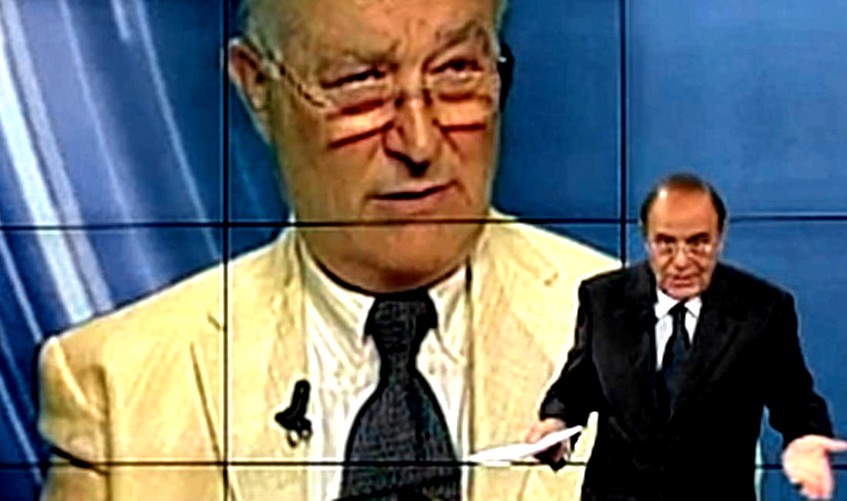
[Above: Sollecito’s father Francesco on Italian national TV being made to admit the book lied]
The Sollecito/Gumbel book is an “own goal”
In Italy the extremely inaccurate and hyper-aggressive book has already set themselves up for two kinds of trouble
The Gumbel and Sollecito book was released in English on 18 September 2012 and within ten days all of Italy knew that the book was a crock.
Sollecito’s own father and own lawyers Bongiorno and Maori have already been forced to admit the book contains serious lies.
Already the prosecution has indicated that they are weighing whether there might be new charges lodged against Sollecito.
Analysis Of 3 Claims Of Criminal Conduct
We focus on three claims by Sollecito and Gumbel of criminal behavior which have already been widely repudiated by the Italian press.
1. A deal was sought by prosecution to frame Knox
Sollecito’s own father Francesco was made to concede by the host and all other guests on the popular Porta a Porta TV show last week that Sollecito lied in claiming that the prosecution had sought a deal under which Sollecito would frame Amanda.
Such a deal would be illegal so Sollecito was falsely accusing prosecutors of a very serious crime. Francesco Sollecito backed down even more in some interviews later. One of Sollecito’s own lawyers, Luca Maori, immediately denied in obvious frustration that the offer of any deal either way ever happened, and Giulia Bongiorno soon publicly agreed. .
2. A long brutal interrogation on 5-6 November 2007
Sollecito has suddenly claimed in the book, nearly five years after he said it happened, in face of vast evidence including his own writings to the contrary, that police interrogated him over 10 hours, and abused and threatened him.
But he was demonstrably not ever interrogated over 10 hours, and he folded fast when they showed him his phone records, which contradicted his earlier alibis, and so he promptly laid the blame on Amanda.
The English translations of the lengthy court transcripts of those many who were present at the central police station on the night all coincide, and damn the version cooked up by Sollecito and Gumbel..
3. Deliberately wrong reasoning in the Galati appeal
All this trouble flows from half a dozen pages of Sollecito’s book made public in Italy! Here now are several more pages not yet known about there (we will have many more) which our poster ZiaK has translated into Italian to help everybody to read. Sollecito ridicules both Dr Galati and his appeal. Let’s see:
- Dr Galati is recognised as one of the most brilliant lawyers in Italy, and he is a former Deputy Chief Prosecutor at the Supreme Court, specially assigned to Perugia because cases involving the central government are handled there when they are too hot to handle in Rome.
- Solllecito is of course a 28-year old student with a cocaine record and a long history of parental supervision who has never held a job in his life. He failed the entrance exam in virtual reality for the University of Verona but still has delusions of a career in computer games.
And surely Gumbel would never have got the job if Bongiorno and Maori had the opportunity to size up how wildly incompetent about the law and the case and and twisted in his mind about Italy he seems to be.
These ill-advised pages below show Sollecito’s and Gumbel’s profound ignorance of Italian jurisprudence, a total incomprehension of the wide scope of the appeal, and their contempt toward the advice from his lawyers.
Passages highlighted are wrong on the hard facts as shown in part 2 below.
1. What The Sollecito/Gumbel book claims
Judge Hellmann’s sentencing report was magnificent: 143 pages of close argument that knocked down every piece of evidence against us and sided with our experts on just about every technical issue. It lambasted both the prosecution and the lower court for relying on conjecture and subjective notions of probability instead of solid evidence. And it launched a particularly harsh attack on Mignini for casting aspersions on the very concept of proof beyond a reasonable doubt.
Mignini had dismissed it in one of his court presentations as a self-defining piece of linguistic trickery. Hellmann pointed out that reasonable doubt was now””belatedly””part of the Italian criminal code. A case built on probability alone, he said, was not sufficient and must necessarily lead to the acquittal of the defendant or defendants.
The prosecution’s rebuttal of the sentencing report, filed a couple of months later, was little short of astonishing.
It accused Hellmann of indulging in circular arguments, the old rhetorical fallacy known to the ancients as petitio principii””essentially, starting with the desired conclusion and working backward. The criticism applied much more accurately to what the prosecution and Judge Massei had done themselves; everything, even the absence of evidence, had been a pretext for them to argue for our guilt. But the author of the prosecution document, Giovanni Galati, chose not to dwell on such ironies. Instead, he attacked Hellmann””I wish I were joking about this””for resorting to deductive reasoning. Making yet more allusions to grand rhetorical principles, Galati said he had a problem with the appeals court taking the available evidence and seeking to make each piece follow on logically from the last. I take it he is not a fan of Sherlock Holmes.
Galati seemed incensed that Hellmann had found the “superwitnesses” unreliable. He argued that Hellmann’s problem with Antonio Curatolo, the heroin addict in Piazza Grimana, was not his failure to be consistent about the details of when and where he had supposedly seen us but rather Hellmann’s own “unwarranted prejudice against the witness’s lifestyle.” Galati even dared to embrace Curatolo’s argument that heroin is not a hallucinogen to insist he must have been telling the truth.
These arguments, to me, made a mockery of civilized discourse. I don’t honestly know how else to characterize them.
From my experience, I also know they are the bread and butter of the Italian legal system, the peculiar language in which arguments and counterarguments are formed every day. Not only do innocents go to prison with shocking regularity, while guilty people, equally often, win reprieve or acquittal; magistrates and judges who make the most howling errors rarely pay for their mistakes.
See Part 3 below for an Italian translation of the above, kindly supplied by main poster ZiaK.
2. Correctly explaining Cassation’s reasoning
Read all the posts here. Also read all the posts linked to here.
Italy’s excellent justice system is in fact exceptionally pro defendant, and prosecutors have to jump through more hoops than any other system in the world. Major errors and framings of innocent parties never make it through to a final guilty verdict.
Correctly understood in light of that system, there was nothing magnificent about the Hellman-Zanetti outcome. The Hellmann court is KNOWN to have been hijacked.
And these posts by Cardiol and James Raper show the report was written by two biased and wrongly qualified judges way out of their depth on both the evidence and the law.
Here is main poster Machiavelli’s explanation of what Sollecito.doesn’t get. The required logic Sollecito is ridiculing is intrinsic to Italian jursprudence (and US and UK jurisprudence) and is REQUIRED by the Supreme Court.
In plain English, Dr Galati is saying that Hellmann-Zanetti ignored that requirement.
Instead, they illegally went cherrypicking, with an extreme pro-defendant bias up-front. Bold text here is to emphasize that.
2. The failure to apply the inferential-inductive method to assess circumstantial evidence. This is a key point based on jurisprudence and is in fact a devastating general argument against Hellmann-Zanetti:
The appeal to Cassation’s jurisprudence on the circumstantial case originates from the fact that the Assize Appeal Court did not deploy a unified appreciation of the circumstantial evidence and did not examine the various circumstantial items in a global and unified way.
With its judgment it has, instead, fragmented the circumstantial evidence; it has weighed each item in isolation with an erroneous logico-judicial method of proceeding, with the aim of criticizing the individual qualitative status of each of them ..
Dr Galati accuses the appeal court of focusing on the quality of some pieces of circumstantial evidence, instead of their correlation to each other as the Supreme Court always requires. .The appeal judges, in actual fact, deny that the probative reasoning and the decisive and cognitive proceeding of the court is to be found in the circumstantial evidence paradigm of the hypothetico-probabilistic kind, in which the maxims of experience, statistical probability and logical probability have a significant weight.
The court must reach a decision by means of the “inductive-inferential” method: it proceeds, by inference, from individual and certain items of data, through a series of progressive causalities, to further and fuller information, so arriving at a unification of them in the context of [13] the reconstructed hypothesis of the fact.
This means that the data, informed and justified by the conclusions, are not contained in their entirety in the premises of the reasoning, as would have happened if the reasoning were of the deductive type “¦ (..) A single element, therefore, concerning a segment of the facts, has a meaning that is not necessarily unambiguous.
Dr Galati cites and explains further:
The Perugia Court of Appeal has opted, instead, precisely for the parceled-out evaluation of individual probative elements, as if each [14] one of them must have an absolutely unambiguous meaning, and as if the reasoning to be followed were of the deductive type.
This error emerges from the text of the judgment itself, but the gravity of the error committed by the Court in its decision derives from the fact that even the individual elements had been acquired by the cognitive-decisioning process in a totally partial manner, isolating the sole aspect that allowed the recognizing of doubts and uncertainties in the element itself..
So Galati-Costagliola concludes ““ and this by now is obvious ““ that the Hellmann-Zanetti court followed a “deductive only” paradigm on pieces in isolation, instead of the “inferential-inductive” paradigm prescribed by Supreme Court requirements (1995).
Moreover, Hellmann-Zanetti applied a deductive paradigm of assessment only to some cherry picked aspects of the single isolated pieces of evidence, overlooking other qualities of the single piece (an example ““ my own ““ is the possible “contamination” of the bra clasp found on the floor in the murder room.) Ordering an assessment of the quality of any element as if it was a proof in isolation from the rest of the evidence is itself unlawful.
But Hellmann”“Zanetti also picked out of the evidence one aspect alone, for example it points to the theoretical possibility of contamination by touching from gloves, but does not consider the negative check results from the possible contamination sources. The interpretation of X-DNA from the bra-clasp by Vecchiotti in the conclusion is worded as if to ignore the results on the Y-haplotype, and so on.
So even single aspects/qualities of isolated items are further isolated from other aspects by Hellmann-Zanetti, and are assessed without looking for a relationship to the context. This is a core violation of the basics of jurisprudence in cases based on circumstantial evidence.
3. Italian Version of the passage on the Cassation appeal from Sollecito’s book
This translation is kindly provided by main poster ZiaK.
Il rapporto di motivazioni del giudice Hellmann fu magnifico: 143 pagine di ragionamenti serrati che demolirono ogni singolo pezzo di prova contro di noi, e che con riferimento a quasi ogni questione tecnica presero le parti dei nostri esperti. Il rapporto strigliò sia la pubblica accusa, sia la corte di prima istanza per il loro affidamento ai congetture e ai nozioni soggettivi di probabilità invece di dipendere su prove solide. Perdipiù, il rapporto sferrò un attaco particolarmente severo su Mignini per aver denigrato il concetto stesso di prova oltre ogni ragionevole dubbio. Mignini aveva già scartato questo concetto come un inganno linguistico auto-determinante nel corso di uno delle suoi presentazioni alla corte. Hellmann fece notare che il dubbio ragionevole fa ormai - tardivamente - parte del codice penale italiano. Una causa stabilita unicament su probabilità , disse Hellmann, non é sufficiente e deve necessariamente condurre all’assoluzione del imputato o degli imputati.
La confutazione del rapporto della parte dell’accusa, presentato in appello un paio di mese dopo, fu quasi una cosa sbalorditiva.
Accusò Hellmann di abbandonarsi a argomentazioni viziosi, in quella vecchia falsità retorica conosciuta dagli antichi come petitio principii - cioè,sostanzialmente, partire dalla conclusione desiderata per poi andare a ritroso. Questa critica potrebbe essere applicata con molto più precisione a ciò che fecero l’accusa e il giudice Massei stessi: tutto - compresa anche la mancanza di prove - gli é servito di pretesto per dare appiglio agli loro argumenti sostenendo la nostra colpevolezza. Ma l’autore di quel rapporto della pubblica accusa, Giovanni Galati, scelse di non soffermarsi su queste ironie. Al contrario, preferii attacare Hellmann - io desideri davvero fossi solo scherzando su questo punto - per il suo aver ricorso al ragionamento deduttivo. Perdipiù, facendo ancora altre allusioni a grandi principi retorici, Galati si dichiarò insoddisfatto del fatto che la Corte d’appello avesse preso prove disponibili e avesse cercato di far seguire in modo logico un pezzo dopo l’altro. Devo supporre che Galati non sia un tifoso di Sherlock Holmes.
Galati sembrò furibondo che Hellmann avesse trovato inaffidabili gli “supertestimoni”. Sostenne che la difficoltà che Hellman terrò a proposito di Antonio Curatolo, il tossicomane della Piazza Grimana, non fu la sua incapacità di ricordarsi con coerenza i dettagli su quando e dove fossimo presumibilmente visti, ma piuttosto il “pregiudizio ingiustificato contro il modo di vivere del testimone” mantenuto del stesso Hellmann. Galati osò persino cogliere l’argomento di Curatolo, secondo il quale l’eroina non é un allucinogeno, per sostenere che Curatolo avesse dovuto dire la verità .
Tali argomentazioni, al mio parere, svuotino il discorso progredìto di tutte le sue valori. In onestà , non saprei descriverli in modo diverso. Nella mia esperienza, so anche che sono il fondamento del sistema giuridico italiano, e della la lingua particolare nella quale gli argumenti e controargumentazioni sono formulati ogni giorno. Non solo gli innocenti vengono incarcerati con preoccupante frequenza, mentre le persone colpevoli con altrettanto frequenza ottengono sospensione o assoluzione, ma anche i magistrati ed i giudici che fanno gli più strepitosi errori pagano raramente per i loro sbagli.
.
[Below: Sollecito’s lead lawyer Bongiorno. Still in shock? She has made no statement yet on his book]
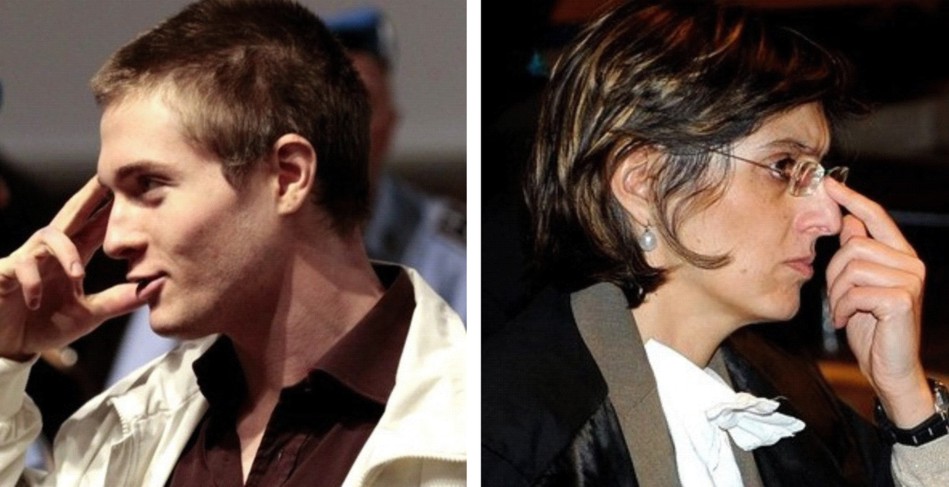
Monday, April 30, 2012
Does ANY Competent Lawyer Believe RS And AK Are 100% Innocent? If So See These Questions
Posted by James Raper
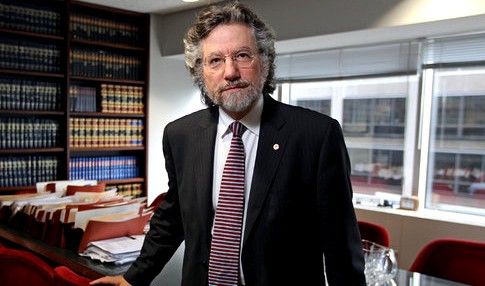
[Above: Knox defense legal advisor Ted Simon increasingly seems to have some explaining to do]
After 3 days and growing, unfortunately no sign that pro-innocence lawyers (if any) want to respond. Mr Simon? Mr Barnett? Ms Nancy Grace? (Well perhaps not you)
The Italian, US and UK lawyers who guide TJMK (of which I am one) look around and wonder: why are genuinely-convinced pro-Knox lawyers (if any) still not comprehensively answering all the open questions?
I contrast this with the various media talking heads who have offered drive-by comments without a really deep understanding of the facts of the case or Italian law.
In the law of all three countries, defense lawyers don’t need to KNOW either way whether their client is guilty or innocent. They don’t have to come out with a complete scenario to account for all the facts and point to innocence that would be the counterpart to my scenario (powerpoints - wait a few seconds to load) seemingly accounting for all the facts, which is still an unchallenged case for guilt.
But a comprehensive rebuttal would do the hard-pressed Sollecito and Knox factions a big favor, and provide a much-needed framework for the media (which is posting many incorrect legal claims), and make the Cassation appeal and the book-writing by Knox and Sollecito so much easier.
Consider the ups-and-downs of the defense legal teams on the case,
It was clear in 2008 that her lawyers absolutely didnt like Knox speaking out, offering different versions that between them made her look distinctly guilty. They didnt like the anti-Mignini campaign run from Seattle and they publicly said so - when Mr Mignini was attacked by a main speaker at an event at Salty’s they actually spoke up and publicly defended him.
In December 2008 NBC TV aired an excellent Dateline report. The main legal talking head, Ted Simon, explained that this was a really tough prosecution case to beat, and that whacking down individual points of evidence would not win the case in the public eye (justice would not be seen to be done) and that only a complete alternative explanation of the crime would do.
At trial in 2009 the defense teams did what they could with a torrent of facts and two unpredictable clients. The cross-examination of Amanda Knox on the stand mid-year in the context of Patrick Lumumba’s alleged framing must have seemed a real low-point for them, as she came across as rather flippant and chilling, and she said a number of things that all defense lawyers would probably prefer that she hadn’t.
Through the publication of Judge Massei’s report the defenses seem to have been faced with an uphill battle.
In 2011 an experienced criminal-case judge was initially appointed to preside over the first appeal. But quite suddenly, to the surprise of many in Italy and the alleged unhappiness of the judge himself, he was removed from the case, and Judge Hellman was appointed in his place.
Defence counsel would of course have had no role in that surprise change of lead judges for the first appeal, but from Day One of the appeal (spaced out to one session a week by Judge Hellman to suit one of them) the defenses seemed much happier.
The prosecution were now on occasion publicly hinting that they were now stuck with the uphill battle. The defenses now seemed the side energized and confident. But please note these three things which suggest that they knew they were not all-powerful.
- 1) They appealed on very narrow grounds, essentially on some witness testimony and a small part of the forensic evidence, and they kept well away from the multiple alibis, mobile phones and computers, and forensic evidence in the hallway, bathroom, and Filomena’s room.
2) They never argued that Rudy Guede was the lone-wolf killer in the case (the surprise preference in his report of Judge Hellman) and even put their own witnesses Alessi and Aviello on the stand to in effect try to prove otherwise.
3) Knox legal advisor Ted Simon was reduced to arguing on TV that there was no evidence of Knox and Sollecito IN the bedroom, while never accounting for the mishmash of alibis or all the mixed-blood and footprint evidence just outside the door.
As Dr Galati’s appeal and public opinion in the three countries are showing, the defences may have mostly won the second battle, with Judge Hellman’s interim verdict and sentence (Knox was still sentenced to three years), but they seem to be falling far short of winning the war for the two clients.
Now the defences again face an uphill battle.
So here we go. An opportunity for any good pro-innocence lawyer to help to win the war for Knox and Sollecito. Forget the forensics for now. I offer these several dozen questions for you and/or Amanda Knox which, truthfully answered, might put many concerns to bed.
I will be happy to post here any real attempt at answering all of these questions by any qualified lawyer who is thoroughly on top of the case - or of course any attempt by Amanda Knox herself.
1. Why did you not mention the 16 second 12.07 phonecall to Meredith’s English phone on the 2nd November in your e-mail? When explaining why you made this call, please also explain why it was to the English phone rather than Meredith’s Italian phone which you knew Meredith used for local calls?
2. Why did you not mention this call when you phoned Filomena immediately afterwards?
3. Why did you make so little effort to contact Meredith again after being told by Filomena to do so. Remember the logged 3 and 4 second phone calls?
4. Why did you tell Filomena that you had already phoned the police when neither you, nor Raffaele, had.
5. Can you and will you explain the contradiction between your panic at the cottage (as described in the e-mail) and the testimony of all the witnesses who subsequently arrived that you appeared calm, detached and initially unconcerned as to your friend’s whereabouts or safety?
6. Why did you tell the postal police that Meredith often locked her bedroom door, even when it came to taking a shower, when this was simply not true, as Filomena testified?
7. Can you and will you explain why you did not try either of Meredith’s phones at the cottage if you were indeed in such a panic about Meredith’s locked door?
8. Can you and will you explain how you knew that Meredith’s throat had been cut when you were not, according to the witnesses’s testimony, a witness to the scene in Meredith’s bedroom after the door had been kicked in and, with the exception of probably a postal police officer or the ambulance crew, no one had looked underneath the duvet covering the body when you were there?
9. What made you think that the body was in the cupboard (wardrobe) when it was in fact to the side of the wardrobe? Were you being flippant, stupid, or what, when you said that? Do you think it just a remarkable coincidence that the remark bears close comparison to the crime scene investigators conclusions, based on the blood at the scene, that Meredith had been shoved, on all fours, and head first, at the door of the wardrobe? She was then turned over on the floor and moved again. How did you know that there was any position prior to her final place of rest?
10. Will you ever be able to account for the 12.47 pm call to your mother in Seattle ( at 4.45 am Seattle time)? Do you remember this now because it was not mentioned in your e-mail nor were you able to remember it in your court testimony?
11. Why do you think Raffaele told the police ““ contrary to your own alibi that you had spent the whole time with Raffaele at his apartment ““ that you had gone out at 9 pm and did not return until 1 am?
12. Did you sleep through the music played for half an hour on Raffaele’s computer from 5.32 am?
13. Were you telling the truth when you told the court that you and Raffaele ate dinner some time between 9.15 and 11 pm? Can you not narrow it down a bit more? The water leak occurred, you said, whilst washing up dishes after dinner. Why then did Raffaele’s father say that Raffaele told him at 8.42 pm about the water leak whilst washing up dishes?
14. What was the problem about using the mop, rags, sponges etc already at Raffaele’s apartment, to clear up a water spill? Why was the mop from the girl’s cottage so essential and if it was, why not collect it immediately since it was just a short distance away?
15. Why, when you knew that you were going to Gubbio with Raffaele on the 2nd November, did you not take a change of clothing with you, if needed, when you left the cottage on the afternoon of the 1st?
16. Why did you need a shower at the cottage when you had already had one at Raffaele’s apartment the previous evening?
17. If you had needed one again why not have it at his apartment, in a heated apartment, before you set off, or on your return, rather than have a shower on a cold day, in a cold flat?
18. Why did you not notice the blood in the bathroom, and the bloody footprint on the bathmat, until after your shower? If the blood you then observed was already diluted and faded, how do you explain this?
19. Do not ignore your blood on the faucet. In your own testimony you said that there was no blood in the bathroom when you and Raffaele left the flat on the afternoon of the 1st. What is your considered take on this now? Did your ear piercings bleed when having that shower or drying afterwards? If so, why were you not perfectly clear about the matter in your e-mail? But then again you said that the blood was caked dry, didn’t you?
20. Why did Raffaele say that, on entering the flat with you, Filomena’s door was open and he saw the damage and mess inside, but you said, in your e-mail, that Filomena’s door was closed when you returned at 10.30 am? Did you subsequently look inside on that occasion, or not? It’s just that if you did, then why did you not mention the break in to Filomena prior to you and Raffaele returning to the cottage?
21. You are a creative writer so please explain. What is the point of the word “also” in the following extract from your e-mail? “Laura’s door was open which meant that she wasn’t at home, and Filomena’s door was also closed”.
22. In your trial testimony you mentioned shuffling along the corridor on the bathroom mat after your shower. From the bathroom to your room. Because there was no towel in the bathroom. You had left it in your bedroom. Then back again. Why is this not mentioned in your e-mail?
23. In your e-mail you stated that you changed for your shower in your bedroom, and then afterwards dressed in your bedroom. That makes sense. What you don’t explain is why, if you towelled and dressed in your bedroom, there was any need to shuffle back to the bathroom on the bathmat. Why not just carry it back?
24. But why, in the same testimony, did you then change your mind as to where you had undressed for your shower? Not in your bedroom - saying so was a mistake you said - but you did not say where. Some people might think, uncharitably, that your change of mind was necessary to incorporate the double bathmat shuffle.
25. Were there any things that you disliked about Meredith? Be honest because we know from her English friends and other sources that there were things that she disliked about you.
26. Why are pages missing from your diary for October?
27. Once again, and this time so that it makes some sense, please explain why you permitted the police, on your say so, to believe that poor Patrick Lumumba was involved in Meredith’s murder. Clearly, had you been at the cottage you would have known that he was not, and had you not been there you could not have known that he was.
There are actually over 200 open questions on this site, and I can think of others, but I consider these between them to be the core several dozen that relate to the quirks,contradictions, omissions and inconsistencies in Amanda Knox’s own account and behaviour. Answer all of these and in the public eye Amanda Knox really could be home free.
Tuesday, February 07, 2012
Knox Team to Appeal Conviction And 3-Year Sentence For Framing Patrick Lumumba
Posted by Peter Quennell
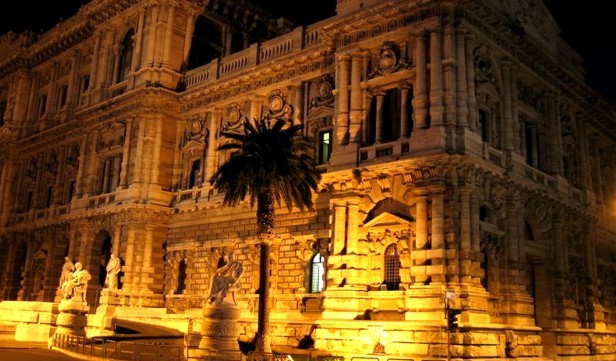
[Above: the Supreme Court of Cassation]
Appeals against Judge Hellman’s rulings must be lodged in Rome by 18 February.
Now Reuters is reporting a Knox-team appeal apparently announced by David Marriott. The Knox team probably had little choice but to lodge this seeming long-shot of an appeal.
Judge Hellman’s ruling left her “half pregnant” facing a hard-line and unbendable Supreme Court and it left her mom and dad more vulnerable in their own trial for calunnia for claiming in a UK interview that Knox only “confessed” in fingering Patrick because of duress.
Explanation of calunnia
The charge of calunnia (art. 368) has been commonly translated as “slander” in the English/US media. This translation is incorrect, however, as calunnia is a crime with no direct equivalent in the respective legal systems.
The equivalent of “criminal slander” is diffamazione, which is an attack on someone”Ÿs reputation. Calunnia is the crime of making false criminal accusations against someone whom the accuser knows to be innocent, or to simulate/fabricate false evidence, independently of the credibility/admissibility of the accusation or evidence.
The charges of calunnia and diffamazione are subject to very different jurisprudence. Diffamazione is public and explicit, and is a more minor offence, usually resulting in a fine and only prosecuted if the victim files a complaint, while calunnia can be secret or known only to the authorities. It may consist only of the simulation of clues, and is automatically prosecuted by the judiciary.
The crimes of calunnia and diffamazione are located in different sections of the criminal code: while diffamazione is in the chapter entitled “crimes against honour” in the section of the Code protecting personal liberties, calunnia is discussed in the chapter entitled “crimes against the administration of justice”, in a section that protects public powers.
Judge Hellman essentially contradicted Cassation’s ruling on Guede which agreed strongly that Guede and two others did it (Judge Hellman of course went for the very tenuous lone wolf approach which Judge Micheli and Judge Massei both shot down in some detail) which had many lawyers in Italy doing double-takes.
Knox in fact fingered Patrick when she was merely a witness who had not even been invited to Perugia police headquarters for the evening and who had volunteered for the questioning.
The interrogators have all claimed she was under no duress except the duress of hearing that Sollecito in the next interrogation room had just called her a liar and destroyed the latest of her various alibis.
Then she had several weeks (as did her mom) to move to spring a devastated Patrick from an adjacent wing in Capanne prison, but of course she didn’t.
Her lawyers never lodged a complaint against the claimed duress and on the witness stand at trial in mid-2010 the prosecutors actually got her to admit that she was treated well.
Key at this stage may be that Knox cannot use her natural advantages of being young and rather dopey and of being able to speak up in court at any time, not under oath or cross-examination, which she used twice in front of Judge Hellman (with lusty sobs and tears for herself and no caring for Meredith).
Cassation works like Supreme Courts elsewhere in Europe and the United States They receive the written appeals and then months or even years later hold very brief hearings, and then almost immediately issue a ruling. It looks to us like the case almost certainly gets bounced back to Perugia - and a new judge - for re-working.
Judge Hellman may have found Patrick’s highly aggressive lawyer impossible to overrule, and he would have been wildly unpopular in Italy to leave Patrick without even his small settlement. If Patrick’s lawyer does not somehow react to this appeal it will be a surprise. He may have the opportunity for rebuttal.
This case has thrown up a lot of possibilities for shortening the Italian process in murder cases and leveling the playing field in favor of victims and families. We’ll round up and post ideas for such reforms already being pushed in Italy by reformers such as Barbara Benedettelli.
Reforms might include no right to defendant statements in court without the possibility of cross-examination, the limiting of judges’ scopes in first appeals, and no jury being required for those appeals.
But everybody sure appreciates those judges’ and juries’ written statements. A precedent the whole world could use.
Wednesday, January 25, 2012
The Curt Knox And Edda Mellas Diffamazione Trial Will Resume In Perugia 30 March.
Posted by Jools

First, here is an explanation of diffamazione.
The charge of calunnia (art. 368) has been commonly translated as “slander” in the English/US media. This translation is incorrect, however, as calunnia is a crime with no direct equivalent in the respective legal systems.
The equivalent of “criminal slander” is diffamazione, which is an attack on someone”Ÿs reputation. Calunnia is the crime of making false criminal accusations against someone whom the accuser knows to be innocent, or to simulate/fabricate false evidence, independently of the credibility/admissibility of the accusation or evidence.
The charges of calunnia and diffamazione are subject to very different jurisprudence. Diffamazione is public and explicit, and is a more minor offence, usually resulting in a fine and only prosecuted if the victim files a complaint, while calunnia can be secret or known only to the authorities. It may consist only of the simulation of clues, and is automatically prosecuted by the judiciary.
The crimes of calunnia and diffamazione are located in different sections of the criminal code: while diffamazione is in the chapter entitled “crimes against honour” in the section of the Code protecting personal liberties, calunnia is discussed in the chapter entitled “crimes against the administration of justice”, in a section that protects public powers.
The suit against Curt Knox and Edda Mellas will commence in earnest on 30 March.
That is two days after the scheduled start of the Sollecito family trial in Bari for alleged subversion of justice, and about six weeks after the prosecution lodges its grounds for appeal with the Supreme Court against the appeal verdict on Amanda Knox and Raffaele Sollecito.
The defamation charges were lodged not by the Perugia prosecutors’ office but by those who considered themselves to have been defamed. Under their rules they are required to do that to safeguard the system.
Amanda Knox is quoted as saying how much she likes Italy and how she would like to be at that trial.
Amanda Knox “loves Italy and likes Perugia”.
She wants to return as a tourist but, if necessary, she’ll do so to testify in the trial against her parents”. To say as much was one of the defenders of the American [female], lawyer Carlo Dalla Vedova. Words came in the space of the proceedings for defamation against the parents of the student from Seattle, which is taking place in Perugia.
The name of Amanda Knox was included in the list of trial witnesses that the defence for Kurt Knox and Edda Mellas, lawyers Dalla Vedova and Luciano Ghirga intend to call to testify in court. “Both are accused of libel through the press in an interview which appeared in 2009 on the website of The Sunday Times” in which they spoke of alleged abuses on her daughter at the police headquarters during the questioning for the investigation into the murder of Meredith Kercher. For which crime Knox was provisionally acquitted on appeal.
In the meantime today the single judge Giuseppe Noviello has rejected an instance by the defence in relation to the territorial incompetence of the Perugian judiciary in dealing with the court proceedings.
“Amanda - said Dalla Vedova - is very interested” in the trial hearings against her parents and to which she is accused of calunnia, also against the flying squad police agents”. With her lawyers she maintains a correspondence by e-mail and every now and then they speak on the phone. “We have not seen her again ““ explains Dalla Vedova - since she was acquitted and went back to the United States. At Christmas though we exchanged greetings and yesterday she sent me an email asking for information on today’s hearing. Tonight I will tell her how it went”.
For the record the hearing in question was then postponed to March 30. On that date the witness for the prosecution will be heard. Then will be the turn for defence witnesses.


